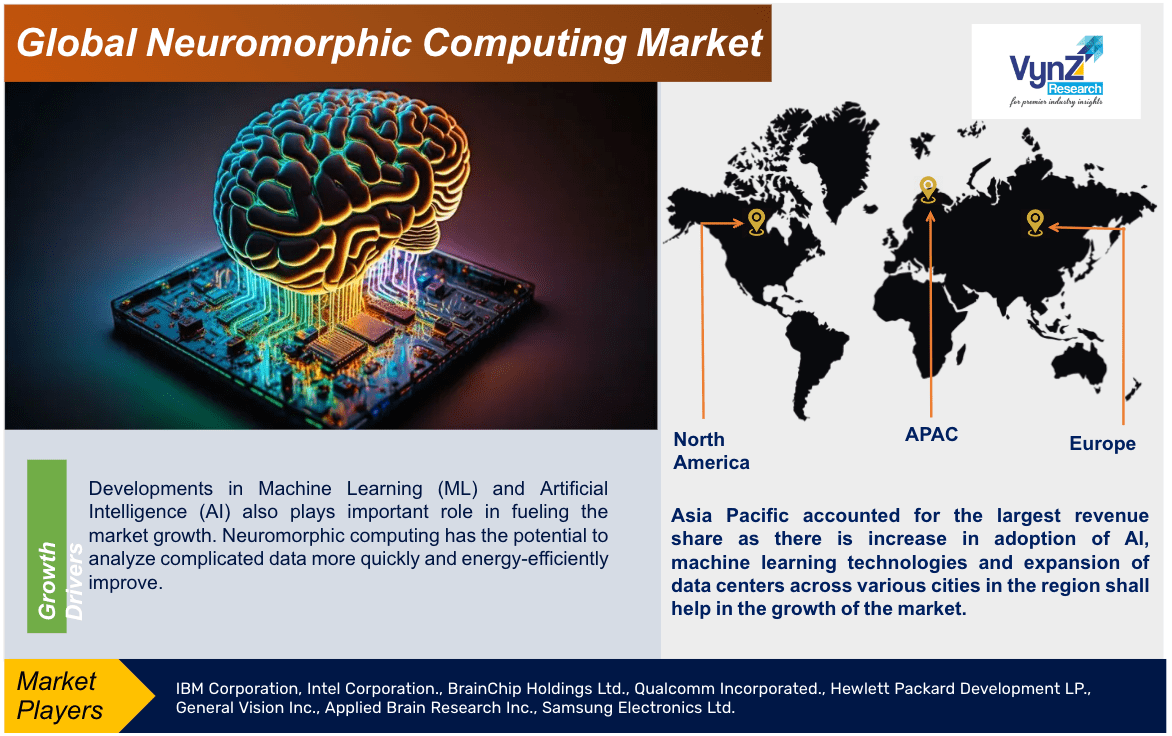| Status : Published | Published On : May, 2024 | Report Code : VRICT5181 | Industry : ICT & Media | Available Format :

|
Page : 205 |

Global Neuromorphic Computing Market – Analysis and Forecast (2025-2030)
Industry Insights By Offering (Hardware, Software and Services), By Deployment (Edge Computing and Cloud Computing), By Application (Image Recognition, Signal Recognition and Data Mining), By Vertical (Automotive, Consumer Electronics, Industrial, Medical, Aerospace, Military and Defense, IT & Telecommunications and Others) and By Geography (North America, Asia-Pacific, Europe and Rest of the World)
Industry Overview
The Global Neuromorphic Computing Market is projected to grow from USD 0.023 billion in 2023 to USD 0.56 billion in 2030 at a CAGR of 88.7% during the forecast period from 2025 to 2030.
Neuromorphic computing is a method of computer engineering in which elements of a computer are modeled after systems in the human brain and nervous system which refers to the design of both hardware and software computing elements. Neuromorphic computing systems mimic the neural networks of the brain to perform complex cognitive tasks such as pattern recognition, decision-making and learning. These systems utilize parallel processing and low-power consumption, making them ideal for applications in robotics, sensor networks, artificial intelligence and data analytics. Neuromorphic chips, software algorithms, and neuromorphic sensors are the key components of neuromorphic computing which is driving innovation in both hardware and software development. In a neuromorphic computer, processing and memory are governed by the neurons and the synapses. Neuromorphic computers are meant to be inherently scalable as adding additional neuromorphic chips entails increasing the number of neurons and synapses that can be realized. It is possible to take multiple physical neuromorphic chips and treat them as a single large neuromorphic implementation to run larger and larger networks.

The market is segregated by offering such as hardware and software, where software segment dominates the market and by deployment like edge computing and cloud computing, among which cloud computing shall grow due to flexibility to scale resources. It is also divided on the application into image recognition, signal recognition and data mining and by vertical divided into automotive, consumer electronics, industrial, medical, aerospace, military and defense, IT & telecommunications and others.
Market Segmentation
Insight by Offering
Based on offering, the Neuromorphic Computing Market is bifurcated into hardware, software and services. Software segment is projected to dominate the market share with the highest CAGR during the forecast period due as it is used in a spectrum of applications such as data modeling, prediction analysis continuous e-learning and real time data streaming.
Insight by Deployment
The Neuromorphic Computing Market is segmented by deployment as edge computing and cloud computing. The Cloud Computing segment is expected to account for the highest market growth during the forecast period due to their flexibility to scale resources and lower hardware and software startup costs.
Insight by Application
By application, the Neuromorphic Computing Market is segregated into image recognition, signal recognition and data mining. Image processing segment is leading the global market for neuromorphic computing due to the advances in image sensors and other processing technologies.
Insight by Vertical
On the basis of vertical, the Neuromorphic Computing Market is divided into automotive, consumer electronics, industrial, medical, aerospace, military and defense, IT & telecommunications and others. Among these, aerospace, military and defense division is anticipated to hold the Neuromorphic Computing Market as it can handle .data processing faster than any other processor. Neuromorphic computing helps in processing enemy movement data and develop simulations that are based on the data processed.
Global Neuromorphic Computing Market Report Coverage
|
Report Metric |
Details |
|
Historical Period |
2018 - 2023 |
|
Base Year Considered |
2024 |
|
Forecast Period |
2025 - 2030 |
|
Market Size in 2023 |
U.S.D. 0.023 Billion |
|
Revenue Forecast in 2030 |
U.S.D. 0.56 Billion |
|
Growth Rate |
88.7% |
|
Segments Covered in the Report |
By Offering, By Deployment, By Application, By Vertical |
|
Report Scope |
Market Trends, Drivers, and Restraints; Revenue Estimation and Forecast; Segmentation Analysis; Impact of COVID-19; Companies’ Strategic Developments; Market Share Analysis of Key Players; Company Profiling |
|
Regions Covered in the Report |
North America, Asia-Pacific, Europe and Rest of the World |
Industry Dynamics
Growth Drivers
Various factors responsible for the growth of the Neuromorphic Computing Market include mimicking brain functionality in which neuromorphic computing seeks to imitate the design and operation of the human brain, specifically with regard to neural networks. Developments in Machine Learning (ML) and Artificial Intelligence (AI) also plays important role in fueling the market growth. Neuromorphic computing has the potential to analyze complicated data more quickly and energy-efficiently improve. Neuromorphic computing architectures that draw inspiration from the structure of the brain, have the potential to save a substantial amount of energy as compared to conventional computing systems. Large-scale neural networks which are capable of handling ever-more-complex tasks can be developed. Scalability is essential for use in advanced simulations, AI solutions and scientific research. Neuromorphic systems are useful in fields like healthcare, banking, and cybersecurity because they can identify patterns and abnormalities in big information. The development of neuromorphic computing systems is aided by advances in hardware designthe f that draw inspiration from the biological structure of the brain. Innovation in the market is also driven by neuromorphic circuits and designs the focus on replication of neuronal functioning. Today number of businesses, academics and research institutes are collaborating to develop the field of neuromorphic computing. Real-time processing capabilities of neuromorphic computing are advantageous for applications like, IoT, edge AI and smart devices.
Restraints
Energy cost of computing and increasing number of applications in which there are energy constraints (such as edge computing applications) is rising which is the major constraint of the neuromorphic computing market. The development of a full software ecosystem is the another restraint. The initial lay out needed to develop and produce neuromorphic chips may offer a challenge for both new and established businesses. Neuromorphic hardware mimics organic neural networks which is a complex design. The design complexity, optimization of neuromorphic architectures and integration causes limitations for their efficient and scalable implementation. The feasibility of neuromorphic systems may be limited by the high power needs, particularly in battery-operated devices.
Geographic Overview
- North America
- Europe
- Asia Pacific (APAC)
- Rest of the World
Geographically, the Global Neuromorphic Computing Market is classified into North America, Europe, Asia Pacific, and the Rest of the world. Asia Pacific accounted for the largest revenue share as there is increase in adoption of AI, machine learning technologies and expansion of data centers across various cities in the region shall help in the growth of the market.
Competitive Insights
IBM is redefining the future of computing as AI has become a crucial part of our daily life. The processing of data in this system is based on deep neural network architectures. To find new hardware solutions that are more power-efficient and better adapted to the specific signal processing operations of interest is important as the number of parameters in such networks continues to grow exponentially. This problem is tackled by exploring new materials and devices that accelerate deep neural network inference and training.
BrainChip is an Australia-based technology leader in edge AI on-chip processing and learning. It specializes in developing advanced artificial intelligence and machine learning hardware. BrainChip brings common sense to the processing of sensor data, freeing machines to do more with less and enabling them to infer the big picture from the basics.
Key Players Covered in the Report
Key players of Neuromorphic Computing Market are IBM Corporation, Intel Corporation., BrainChip Holdings Ltd., Qualcomm Incorporated., Hewlett Packard Development LP., General Vision Inc., Applied Brain Research Inc., Samsung Electronics Ltd.
Recent Development by Key Players
Cornell Tech (applied sciences and engineering campus in New York City) has joined the BrainChip University AI Accelerator Program. Because of this initiative students shall have access to the tools and resources needed to help usher in an era of intelligent AI solutions with a course focused on brain-inspired computing as a part of the curriculum.
Intel has built the world's largest neuromorphic system code-named Hala Point. This large-scale neuromorphic system, utilizes Intel’s Loihi 2 processor, aims at supporting research for future brain-inspired artificial intelligence (AI) that shall tackle challenges related to the efficiency and sustainability of today’s AI. Hala Point advances Intel’s first-generation large-scale research system to achieve over 10 times more neuron capacity and up to 12 times higher performance.
The global Neuromorphic Computing Market report offers a comprehensive market segmentation analysis along with estimation for the forecast period 2025–2030.
Segments Covered in the Report
- By Offering
- Hardware
- Software
- Services
- By Deployment
- Edge Computing
- Cloud Computing
- By Application
- Image Recognition
- Signal Recognition
- Data mining
- By Vertical
- Automotive
- Consumer Electronics
- Industrial
- Medical
- Aerospace, Military and Defense
- IT & Telecommunications
- Others
Region Covered in the Report
- North America
- U.S.
- Canada
- Mexico
- Europe
- Germany
- U.K.
- France
- Italy
- Spain
- Russia
- Rest of Europe
- Asia-Pacific (APAC)
- China
- Japan
- India
- Rest of the World
- Brazil
- Saudi Arabia
- South Africa
- U.A.E
- Other Countries
.png)
Source: VynZ Research
.png)
Source: VynZ Research
Frequently Asked Questions
Purchase Options
Latest Report
Research Methodology
- Desk Research / Pilot Interviews
- Build Market Size Model
- Research and Analysis
- Final Deliverabvle
Connect With Our Sales Team
- Toll-Free: 1 888 253 3960
- Phone: +91 9960 288 381
- Email: enquiry@vynzresearch.com
Neuromorphic Computing Market
